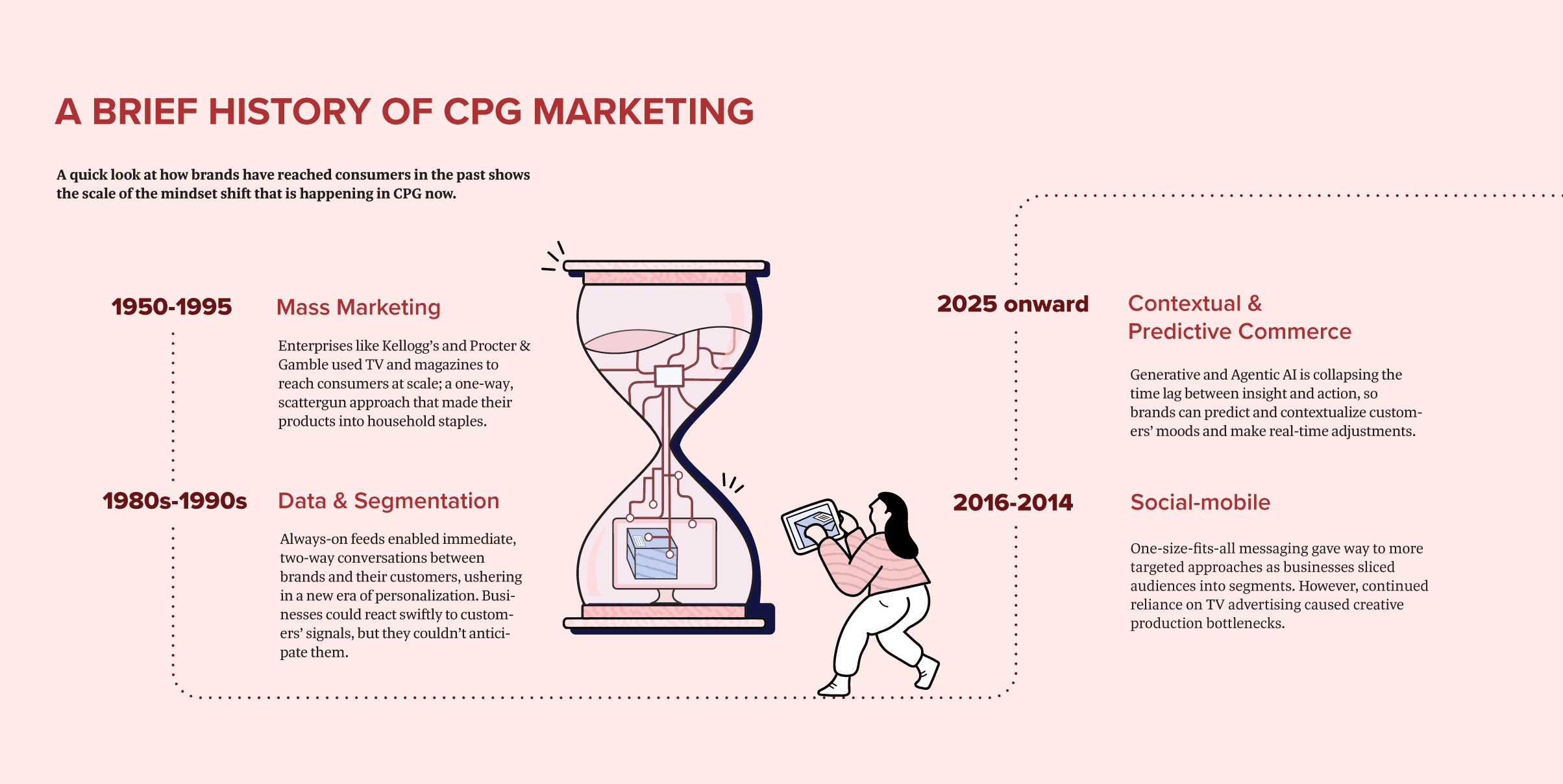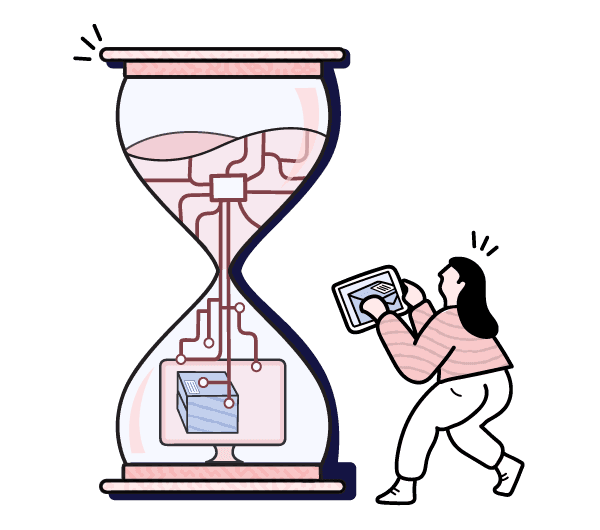
When James Joyce penned the phrase “Here Comes Everybody” in his labyrinthine novel Finnegans Wake, he wasn’t just naming a character; he was summoning an idea. His protagonist was a shapeshifter: was an everyman and any man, at once singular and universal, a figure who contained the noise and nuance of the crowd.
Eighty-six years on, Joyce’s chorus of multiplicity finds an unlikely echo in the aisles of the supermarket. The Consumer Packaged Goods (CPG) industry has become its own stage for everybody, a place where the desires of billions of people surge forward, clamoring to be answered in real time. The CPG world doesn’t deal in abstract characters, but in toothpaste, snack bars, laundry detergents, and cosmetics, yet each product must perform the same trick Joyce’s hero did: be one thing and many things at once.
In today’s market, these stakes are dizzying. Consumers expect products that don’t just serve a function, but anticipate moods, mirror identities, and whisper back personal affirmations. Manufacturers must interpret these shifting signals and spin them into offerings with breathtaking speed. Retailers and brands must carry those products across continents, collapsing the time between impulse and acquisition.
And then there’s the new player in the drama: AI. Algorithms now behave like Joyce’s ever-changing narrator, generating insights, remixing patterns, and predicting the next craving before consumers themselves know it. Data isn’t just a record; it’s a creative partner. Together, consumers, machines, and makers form a restless cast, rushing the stage at once, driven by a single demand: everything, everywhere, right now.
In short, Joyce’s words still resonate. “Here Comes Everybody” could just as easily be the rallying cry of modern CPG, a reminder that in every product on the shelf, there is no single consumer, but the crowd, the chorus, the infinite multiplicity of us all.
A brief history of CPG marketing
A quick look at how brands have reached consumers in the past shows the scale of the mindset shift that is happening in CPG now.

“Traditional marketing media centered on controlling the narrative. Today, with GenAI agents and autonomous systems, the focus is shifting to orchestrating dynamic, adaptive experiences,” explains Prabal Chaudhri, Head of CPG Products at Fractal Analytics.
CPG’s AI moment has arrived
Any big-name CPG firm you can think of is likely to have made at least one AI move already. Autonomous price optimizers, dynamic shelf allocators, and generative brand storytellers are all becoming part of the CPG crowd. They are not all humans – they are AI agents that can contextualize information, plan, and act on it instantaneously.
These tools are helping to create a world where everything – pack design, promotion, shelf layout, even portfolio decisions can be sensed, simulated, and served to every customer moment-by-moment, and at a speed and scale that wasn’t possible before. Here are some examples.
Supply chains don’t just move; they think
Stockouts, pricing errors, promotional errors, and last-mile issues bring costly sales losses. In North America alone in 2024, these issues cost CPG companies $60 billion. That’s why companies are using AI to create more intelligent, dynamic supply chains that can respond quickly to changing trends.
At Mars, the Atlas AI demand-planning suite has unified forecasts across 60 countries, replacing hundreds of spreadsheets with a single AI report. It is wired into the company’s new $450 million smart factory for Royal Canin pet foods, where it flexes production the instant there is a spike in demand. ¹
Content speed beats media spend
Social media and streaming services move at lightning speed. GenAI can help CPG companies to keep pace with consumers’ moods – look at what Unilever is achieving as it partners with thousands of social media influencers.
Unilever’s Beauty AI Studio combines AI with physics, data, and material science to create digital twins of its products. Those twins are then fed into the company’s GenAI Content Studios and Sketch Pro design unit to generate social-first creative content.
The system can spin hundreds of influencer-ready assets for a brand in under 48 hours – twice as fast as traditional methods, at 50% of the cost. A recent campaign for a Dove limited edition racked up 3.5 billion impressions at a fraction of the cost of TV advertising. ²
Digital twins erase the cost curve
Generating content for always-on feeds can also prove expensive – until you put GenAI on the job. Nestlé is combining digital twins of its products with an AI-powered content service, to stay ahead of the game. The system can instantly tailor product assets for different platforms or audiences, without the need for manual effort. It speeds up time to market for seasonal or localized campaigns, while enhancing consistent branding across markets and channels.
Nestle’s digital twins also connect directly to planograms, shopper data, and retail testing. This means that the company can rapidly roll out virtual shelf tests and better position its brands in response to consumer behavior.
Some 10,000 product twins will be created by 2027, but the ones in use today have already cut the company’s e-commerce imagery and shelf-test costs by around 70% - making “design once, localize infinitely” a reality. ³
Human X Machine = Exceptional
We predict that AI agents will outnumber humans in the enterprise by 2027 – so where does that leave humans? The truth is, AI cannot replace human ingenuity. Its true value lies in augmenting it.
The future is not humans or machines. It is humans x machines.
Picture the scene:
At the breakfast brainstorm, a strategist frames a new purpose for a snack brand – and by 10 AM, an AI model has drafted 100 culturally-tuned storyboards.
At the mid-morning shelf check, a planner spots an out-of-stock alert in Lagos – so digital twins reroute the inventory before the first afternoon shopper arrives.
During an afternoon R&D sprint, food scientists sketch a new plant-based meal idea – and GenAI simulations test 1,000 ingredient permutations overnight.
Consumers aren’t the only winners in this scenario. With AI agents on the team, people can give their creativity free reign.
Here’s a real-life example. Procter & Gamble is proving the power of humans x machines with Project Genie, its company-wide GenAI program, which harmonizes point-of-sale, media, and supply data in one place. It has already helped to reduce ad-testing costs by around 90% – but the company wanted to test its value in human, as well as monetary terms.
To do that, it took part in a field study run by Harvard Business School. In a one-day virtual workshop, Procter & Gamble employees were tasked with developing solutions to solve real business challenges facing the company’s brands. The results were impressive. Teams equipped with the data-fed GenAI assistant didn’t just work 12% faster than control groups; they also generated more “exceptional” ideas than either humans or AI alone.
But that wasn’t all. The study found that AI helped employees with different backgrounds to develop more balanced solutions, regardless of their individual expertise. And on a socio-emotional level, AI helped to elevate employee experience and boost morale. ⁴
Four moves to make now
Joyce’s line was both an invitation and a warning: the crowd – both human and AI – is coming whether you open the doors or not. Consumers are routinely using tools like ChatGPT to augment their skills, create content, and boost their purchasing power. Increasingly, they expect the same personalized, instantaneous interactions from their favorite brands. GenAI agents are helping CPG companies to meet those expectations and more.
For those that haven’t begun this journey, now is the time to start. AI is already rewarding the brave, and penalizing the hesitant, at algorithmic speed. Brands that are not onboard will rapidly get left behind.
Of course, it’s not that simple for an enterprise to transform decades of knowledge systems and processes. CPG organizations are still figuring out the role that GenAI agents should play in their business, and the agents themselves are still evolving.
So, how can companies begin to navigate this emerging territory? Here are four key steps to start the journey:
Set a 12-month “AI ambition” that links directly to consumer value, not tech experimentation.
Invest in a cross-functional command center – data scientists sitting beside brand managers, supply planners beside media buyers – to turn real-time insight into real-time action.
Codify a “promise–tool–bargain” – the consumer promise, the AI toolset, and the ethical bargain that governs data use. Transparency breeds trust.
Consider how human x machine teams will work for the business and its people – and invest in governance models to maintain the right balance.
"That’s where Fractal’s deep expertise and domain knowledge come in. We’re partnering with brands to define what AI truly means for their organizations across their people, processes, and infrastructure. And we’re already proving that when humans and machines work together, they can unlock outcomes far greater than either could achieve alone. Fractal is helping enterprises design the future of work today."
References
Mars builds on long-term U.S. investment with the opening of new $450 million Royal Canin facility in Ohio
MARS Leads a Global Digital TransformationUnilever reinvents product shoots with digital twins and AI
Unilever reinvents product shoots with AI for faster content creation
How Unilever Used AI to Make Soap Go Viral
Unilever debuts AI-driven design unit to wean brands off TV-first modelNestlé is creating AI-powered 'digital twins' for brands like Purina, Nescafé Dolce Gusto and Nespresso
Nestlé’s Digital Twin Rollout: A Wake-Up Call for Brands
Nestlé Deploys AI and Digital Twins to Scale Global Content CreationThe Future of Collaboration: How AI is Supplementing Teamwork and Innovation at P&G
P&G, Harvard Study Says Gen AI Gets CPG Teams Working 12% Faster
AI improves both individual and team performance, new study finds. Will companies draw the right lessons from it?
Contributor

Prabal Chaudhri is the Head of CPG Products at Fractal, driving transformation for consumer goods enterprises toward a future where humans and intelligent agents collaborate to create value. With over 20 years of experience across consumer goods, food, retail, technology, and eCommerce, he combines deep CPG expertise with a passion for innovation, brand building, and product development. Prabal holds an MBA from Northwestern University’s Kellogg School of Management and is based in Fractal’s New York office.








